
Today, a whirlwind of technological changes are transforming the way we live – and the way we fly. Here are a few technologies already bringing big changes to the aviation industry:
Virtual Reality
New virtual reality headsets like Oculus are making the promise of ubiquitous virtual reality both practical and achievable in the next five years. Companies are already developing virtual reality programs for flight instruction. Wearing the headsets will completely immerse students in the cockpit of an aircraft without leaving the comfort of home. This is expected to reduce costs for aviation training and make it more accessible – a must in an industry that is currently suffering from a surfeit of pilots.
3D Printing
The 3D printing revolution has already arrived to the aviation industry, and it only promises to grow in the next decade. Today, aviation mechanics and engineers have the ability to print virtually any spare part right in their shop. These parts are not only easy to make, but also 30-55% lighter than traditional parts, and use 90% fewer raw materials. 3D drone printing is already a reality for many civilian enthusiasts, as well. While it may be some time before we see a 3D printed plane, that future is likely just over the horizon as engineers race to create a 3D printed aircraft kit.
Mobile Applications
The spread of digital technology has put a wealth of information at our fingertips. Now we continue the process of developing applications that can help us organize and leverage this information in new and useful ways. Mobile applications can measure altitude, help you plan a flight map, look up common terms, and much more. But the real game-changer will be when a developer fully integrates all of the tools that passengers or pilots need into a single, seamless application.